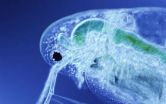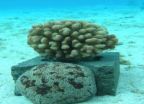(Press-News.org) When battling a deadly parasite epidemic, less resistance can sometimes be better than more, a new study suggests.
A freshwater zooplankton species known as Daphnia dentifera endures periodic epidemics of a virulent yeast parasite that can infect more than 60 percent of the Daphnia population.
During these epidemics, the Daphnia population evolves quickly, balancing infection resistance and reproduction.
A new study reveals that the number of vertebrate predators in the water and the amount of food available for Daphnia to eat influence the size of the epidemics and how these "water fleas" evolve during epidemics to survive.
The journal Science published the results in this week's issue. The National Science Foundation (NSF) and the James S. McDonnell Foundation supported the research.
"This study is a great example of why the most obvious response to disease, increased resistance, may not be the best solution," says Saran Twombly, program director in NSF's Division of Environmental Biology.
"When populations are stressed by other factors such as food or predators, remaining susceptible to a disease is the best route to long-term success."
The study shows lakes with high nutrient concentrations and lower predation levels exhibit large epidemics, and the yeast in the water, Metschnikowia bicuspidata, has less effect on Daphnia as the Daphnia become more resistant to infection.
However, in lakes with fewer resources and high predation, epidemics remain small and Daphnia evolve increased susceptibility to the parasite.
"It's counterintuitive to think that hosts would ever evolve greater susceptibility to virulent parasites during an epidemic, but we found that ecological factors determine whether it is better for them to evolve enhanced resistance or susceptibility to infection," said the paper's lead author Meghan Duffy, a biologist at Georgia Tech.
"There is a trade-off between resistance and reproduction because any resources an animal devotes to defense are not available for reproduction. When ecological factors favor small epidemics, it is better for hosts to invest in reproduction rather than defense."
In addition to Duffy, also contributing to this study are Indiana University biologists Spencer Hall and David Civitello; Christopher Klausmeier, a plant biologist at Michigan State University; and Georgia Tech researchers Jessica Housley Ochs and Rachel Penczykowski.
For the study, the researchers monitored the levels of nutritional resources, predation and parasitic infection in seven Indiana lakes on a weekly basis for a period of four months.
They calculated infection prevalence on live hosts using established survey methods, estimated resources by measuring the levels of phosphorus and nitrogen in the water, and assessed predation by measuring the size of uninfected adult Daphnia.
The researchers also conducted infection assays in the laboratory on Daphnia collected from each of the seven lake populations at two time points: in late July before epidemics began and in mid-November as epidemics waned
The assays measured the zooplankton's uptake of Metschnikowia bicuspidata and the infectivity of the yeast once consumed.
The infection assays showed a significant evolutionary response of Daphnia to epidemics in six of the seven lake populations.
The Daphnia population became significantly more resistant to infection in three lakes and significantly more susceptible to infection in three other lakes.
The hosts in the seventh lake did not show a significant change in susceptibility, but trended toward increased resistance.
In the six lake populations that showed an evolutionary response, epidemics were larger when lakes had lower predation and higher levels of total nitrogen.
"Daphnia became more susceptible to the yeast in lakes with fewer resources and higher vertebrate predation, but evolved toward increased resistance in lakes with increased resources and lower predation," says Duffy.
The study's combination of observations, experiments and mathematical modeling supports the researchers' theoretical prediction that when hosts face a resistance-reproduction tradeoff, they evolve increased resistance to infection during larger epidemics and increased susceptibility during smaller ones.
Ultimately, ecological gradients, through their effects on epidemic size, influence evolutionary outcomes of hosts during epidemics.
"While the occurrence and magnitude of disease outbreaks can strongly influence host evolution, this study suggests that altering predation pressure on hosts and productivity of ecosystems may also influence this evolution," says Duffy.
The team plans to repeat the study this summer in the same Indiana lakes to look at whether the relationships between ecological factors, epidemic size and host evolution they found in this study can be corroborated.
INFORMATION:
Evolving to fight epidemics: Weakness can be an advantage
Less resistance can sometimes be better than more -- at least in a freshwater lake
2012-04-02
ELSE PRESS RELEASES FROM THIS DATE:
Lung cancers detected by CT screening grow as fast as those found with traditional methods
2012-04-02
A new study led by researchers at Mount Sinai School of Medicine indicates that CT scans are more effective than traditional lung cancer detection methods at identifying aggressive lung cancers in their most treatable stages. The data, published online March 27 in the journal Radiology, demonstrate that lung cancers found through annual CT screening are similar to those found in routine practice, both in terms of tumor growth rates and cell-type distribution. In fact, the report showed that 79 percent of the cases diagnosed through annual repeat CT scans were detected at ...
Penn biologists identify a key enzyme involved in protecting nerves from degeneration
2012-04-02
PHILADELPHIA –- A new animal model of nerve injury has brought to light a critical role of an enzyme called Nmnat in nerve fiber maintenance and neuroprotection. Understanding biological pathways involved in maintaining healthy nerves and clearing away damaged ones may offer scientists targets for drugs to mitigate neurodegenerative diseases such as Huntington's and Parkinson's, as well as aid in situations of acute nerve damage, such as spinal cord injury.
University of Pennsylvanian biologists developed the model in the adult fruit fly, Drosophila melanogaster.
"We ...
NIH study finds women spend longer in labor now than 50 years ago
2012-04-02
Women take longer to give birth today than did women 50 years ago, according to an analysis of nearly 140,000 deliveries conducted by researchers at the National Institutes of Health. The researchers could not identify all of the factors that accounted for the increase, but concluded that the change is likely due to changes in delivery room practice.
The study authors called for further research to determine whether modern delivery practices are contributing to the increase in labor duration.
The researchers compared data on deliveries in the early 1960s to data gathered ...
Preventing home invasions means fighting side-by-side for coral-dwelling crabs and shrimp
2012-04-02
As any comic book lover knows, when superheroes band together the bad guys fall harder. The strength that comes in numbers is greater than the sum of its parts.
The same holds true, researchers have recently learned, when different species of crabs (genus Trapezia) and snapping shrimp (Alepheus lottini) in the central Pacific band together to defend their coral homes from hungry seastars. In these frequent conflicts "one-plus-one doesn't always equal two, sometime it is more," explains Seabird McKeon, a marine biologist at the National Museum of Natural History's Smithsonian ...
Study supports using virtual environment to teach mind/body techniques
2012-04-02
A small study from Massachusetts General Hospital (MGH) researchers found that online virtual communities may be an effective way to train patients in meditation and other mind/body techniques. The ability to learn and practice approaches that elicit the relaxation response – a state of deep rest that has been shown to alleviate stress-related symptoms – in a virtual environment could help surmount several barriers that can restrict participation.
"Our finding that a medical intervention – in this case teaching a mind/body approach that includes the relaxation response ...
NASA sees Typhoon Pakhar headed for Vietnam landfall
2012-04-02
The first typhoon of the northern hemisphere 2012 typhoon season is headed for landfall in Vietnam. NASA's Aqua and TRMM satellites have been providing forecasters with valuable data on Typhoon Pakhar, that includes rainfall rates, cloud extent and temperature.
The Tropical Rainfall Measuring Mission (TRMM) satellite flew almost directly over Pakhar when it was a newly formed tropical storm in the South China Sea on March 29, 2012 at 1122 UTC/4:22 p.m. Asia local time (or 7:22 a.m. EDT). The intensifying storm had wind speeds of about 45 knots (~52 mph/~83 kph) and was ...
Images capture split personality of dense suspensions
2012-04-02
Stir lots of small particles into water, and the resulting thick mixture appears highly viscous. When this dense suspension slips through a nozzle and forms a droplet, however, its behavior momentarily reveals a decidedly non-viscous side. University of Chicago physicists recorded this surprising behavior in laboratory experiments using high-speed photography that can capture action taking place in one hundred-thousandths of a second or less.
UChicago graduate student Marc Miskin and Heinrich Jaeger, the William J. Friedman and Alicia Townsend Friedman Professor in Physics, ...
Tokai Pharmaceuticals' galeterone well-tolerated in patients with advanced prostate cancer
2012-04-02
CAMBRIDGE, Mass. and CHICAGO, Ill. -- Tokai Pharmaceuticals, Inc., a biopharmaceutical company focused on developing new treatments for prostate cancer, today announced that its lead candidate galeterone (TOK-001) was well-tolerated with minimal side effects and demonstrated efficacy in patients with castration-resistant prostate cancer (CRPC) in a Phase 1 study. The data will be presented in an oral presentation titled, "ARMOR1: Safety of galeterone (TOK-001) in a Phase 1 clinical trial in chemotherapy naïve patients with castration-resistant prostate cancer (CRPC)," abstract ...
Early clinical data show galeterone safe, effective against prostate cancer
2012-04-02
CHICAGO — Patients with castration-resistant prostate cancer had limited side effects and in many cases a drop in prostate-specific antigen expression with galeterone (TOK-001), a small-molecule oral drug, according to phase I data presented at the AACR Annual Meeting 2012, held here March 31 - April 4.
Castration-resistant prostate cancer (CRPC) is an advanced form of prostate cancer that occurs when the disease progresses after treatment with androgen deprivation therapy. Galeterone works against CRPC by blocking the androgen receptor, reducing levels of the ligand ...
Metformin appeared to slow prostate cancer growth
2012-04-02
CHICAGO — The use of metformin in men with prostate cancer before prostatectomy helped to reduce certain metabolic parameters and slow the growth rate of the cancer, according to the results of a phase II study.
Anthony M. Joshua, M.B.B.S., Ph.D., staff medical oncologist at the Princess Margaret Hospital, University Health Network in Toronto, Ontario, Canada, presented the data at the AACR Annual Meeting 2012, held here March 31 - April 4.
Metformin is the most commonly prescribed medication for diabetes. Prior laboratory research has suggested that metformin may ...
LAST 30 PRESS RELEASES:
Tracing the quick synthesis of an industrially important catalyst
New software sheds light on cancer’s hidden genetic networks
UT Health San Antonio awarded $3 million in CPRIT grants to bolster cancer research and prevention efforts in South Texas
Third symposium spotlights global challenge of new contaminants in China’s fight against pollution
From straw to soil harmony: International team reveals how biochar supercharges carbon-smart farming
Myeloma: How AI is redrawing the map of cancer care
Manhattan E. Charurat, Ph.D., MHS invested as the Homer and Martha Gudelsky Distinguished Professor in Medicine at the University of Maryland School of Medicine
Insilico Medicine’s Pharma.AI Q4 Winter Launch Recap: Revolutionizing drug discovery with cutting-edge AI innovations, accelerating the path to pharmaceutical superintelligence
Nanoplastics have diet-dependent impacts on digestive system health
Brain neuron death occurs throughout life and increases with age, a natural human protein drug may halt neuron death in Alzheimer’s disease
SPIE and CLP announce the recipients of the 2025 Advanced Photonics Young Innovator Award
Lessons from the Caldor Fire’s Christmas Valley ‘Miracle’
Ant societies rose by trading individual protection for collective power
Research reveals how ancient viral DNA shapes early embryonic development
A molecular gatekeeper that controls protein synthesis
New ‘cloaking device’ concept to shield sensitive tech from magnetic fields
Researchers show impact of mountain building and climate change on alpine biodiversity
Study models the transition from Neanderthals to modern humans in Europe
University of Phoenix College of Doctoral Studies releases white paper on AI-driven skilling to reduce burnout and restore worker autonomy
AIs fail at the game of visual “telephone”
The levers for a sustainable food system
Potential changes in US homelessness by ending federal support for housing first programs
Vulnerability of large language models to prompt injection when providing medical advice
Researchers develop new system for high-energy-density, long-life, multi-electron transfer bromine-based flow batteries
Ending federal support for housing first programs could increase U.S. homelessness by 5% in one year, new JAMA study finds
New research uncovers molecular ‘safety switch’ shielding cancers from immune attack
Bacteria resisting viral infection can still sink carbon to ocean floor
Younger biological age may increase depression risk in older women during COVID-19
Bharat Innovates 2026 National Basecamp Showcases India’s Most Promising Deep-Tech Ventures
Here’s what determines whether your income level rises or falls
[Press-News.org] Evolving to fight epidemics: Weakness can be an advantageLess resistance can sometimes be better than more -- at least in a freshwater lake



